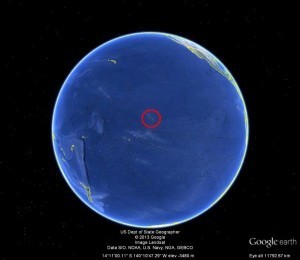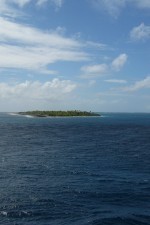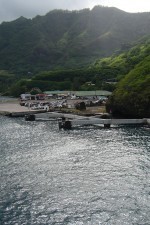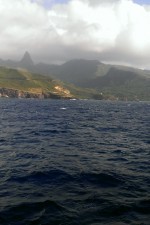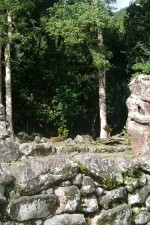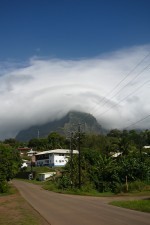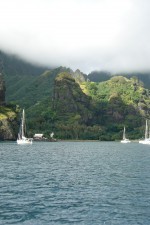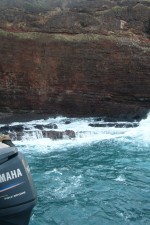Michael Pryor's Blog, page 15
September 25, 2013
Character Vs. Characterisation
I’m about to make a distinction that is bound to be argued with, disagreed with and flat out rejected but, nevertheless, I’m going ahead because I think it’s useful, especially for beginning writers.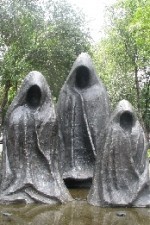
Character is one of the vital aspects of storytelling – this isn’t the controversial bit, by the way, that comes later – and without engaging characters a story is in trouble. That’s why so many writing workshops recommend spending time on compiling character profiles before starting a story.
I’m not going to disagree with this practice. Thinking about a character’s attributes, personality and back story is extremely useful, but there comes a point when a writer asks: ‘How do I let a reader know all this stuff that I know about this character?’
And that’s where we get to the important distinction I want to make. Character is all that stuff you, the writer, know. Characterisation, on the other hand, is how you sneakily, subtly, artfully get it into your story so your reader can learn about your character.
See the difference?
The most straightforward way of characterisation would be to insert your character profile/dossier into your story, perhaps as an introduction or a compulsory appendix. Straightforward, perhaps, but an eye-glazingly bad idea. Doing so would kill any narrative.
I suggest that there are six major ways to do characterisation, to weave details of character into your story without weighing it down. If you use these methods, your reader will gradually accumulate an understanding of your character, almost without knowing she/he is doing it. Some (most?) of these are obvious, but others might take more explanation.
Characterisation through Physical Description
Characterisation through Action
Characterisation through Reaction
Characterisation through Interaction
Characterisation through Dialogue
Characterisation through Thoughts.
Characterisation through Physical Description
This is, perhaps, one of the more obvious methods of characterisation. When done ham-fistedly, it descends into cliché or, even worse, becomes a lazy shortcut. Think of all the evil-looking villains with their black hair, moustaches and goatees, the heroic-looking heroes with their noble jaws and mighty thews, the intelligent-looking scientists with their bald eggheads and glasses. With more thought, though, small physical details can be priceless aspects of characterisation. A mason’s hands, especially the nails. A dancer’s high-arched feet. A weather beaten face.
Characterisation through Action
 This one is sometimes overlooked, particularly in more contemplative writing, but this is the essence of the ‘Show, Don’t Tell’ dictum. ‘By their deeds, ye shall know them’ is something worth taking to heart. And, naturally, by ‘action’ I don’t necessarily mean Big Screen CGI Enhanced Action, although a reader can learn a great deal about a character who risks herself while in a hostage situation to disarm the bomb and save people she really doesn’t like.
This one is sometimes overlooked, particularly in more contemplative writing, but this is the essence of the ‘Show, Don’t Tell’ dictum. ‘By their deeds, ye shall know them’ is something worth taking to heart. And, naturally, by ‘action’ I don’t necessarily mean Big Screen CGI Enhanced Action, although a reader can learn a great deal about a character who risks herself while in a hostage situation to disarm the bomb and save people she really doesn’t like.
Actions can be small, character defining actions like the way someone drives a car, or perpetual fidgets, or the characteristic(!) way someone answers the phone. Actions, and particularly spontaneous actions, can and should reveal details about a character.
Characterisation through Reaction
There’s a good reason for much of what Hollywood does, although after sitting through The Lone Ranger I do wonder. One thing that Hollywood does get right is the Reaction Shot. When something significant happens (an explosion in a shopping mall, a major statement about the status of a relationship) the camera always cuts to a reaction shot. We’re shown the effect that the significant event has.
As in Hollywood, so in your story (sometimes). When something important/significant/moving happens, spend some time focussing on your character and exploring the effect it has had on her/him. Your reader will gain insight when the mother is told that the baby isn’t hers – if the readers get the Reaction Shot.
Characterisation through Interaction
How your character treats people or relates to people can help define her/him. If he/she is kind, overbearing, oblivious or manipulative, this provides the reader with a look into what’s inside. Of course, your character’s external interactions can be in conflict with her/his internal desires, but that’s not a bad thing, either.
Characterisation through Dialogue
Dialogue is good, because that’s what people do – they talk.
Dialogue is a vital part of characterisation. Characterisation through dialogue works in three ways: through what is said, through how it’s said and through the way the character’s conversation works with the other people involved.
What is being said (the content) is fairly straightforward. Your character is always asking for favours. Your character always speaks about him/herself. Your character is constantly making empty threats. All these are a giveaway as to the sort of person she/he is.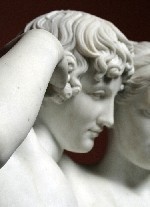
How your character talks is a classic and can be vital in characterisation: the tone, phrases that belong just to him/her, the length of sentences, the rhythm of utterances. Consider all these and you’ll be on the way to deft characterisation through dialogue.
Conversation. This, really, is another aspect of Characterisation through Interaction (above). Does your character interrupt? Does your character ask open questions? Is your character hesitant to speak up in a group?
Characterisation through Thoughts
Readers often learn about a character through their internal monologue. First person narratives are full of this, but third person narratives can also use this technique. What a character thinks, or questions, in the privacy of her/his own skull let us understand their motivations, desires and wishes.
Two words of warning, though. Firstly, watch out that you don’t get too obvious here and start telling your reader all sorts of things. Lead your reader, don’t hit him/her on the head with a hammer. Secondly, I get tired of extended internal monologues that are actually thinly disguised author intrusions where the writer is making damn sure that the readers don’t miss something. It’s clumsy, and it’s also unnatural. People don’t think like that! Rarely do we construct long, uninterrupted, philosophical/political/mystical internal ponderings. Thoughts are fleeting, wandering, fragmentary and distracted – not really the stuff of coherent storytelling.
Of course, all of the above is advice and, like all writing advice it isn’t meant to be comprehensive. Many other characterisation techniques are available. And, equally obviously, this advice needs to be implemented judiciously. If you try to do all of this you’ll overburden your reader – and you’ll slow your story down until it grinds to a halt. Be clever, be adroit, be nimble and your characters will be better off for it.
September 18, 2013
Boy’s Own Paper
The Boy’s Own Paper was a long-running (1879-1967) magazine that, in some ways,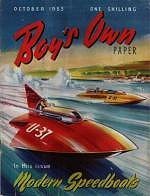 helped to establish and perpetuate the essence of the British schoolboy. Originally, its purpose was educative and it never really lost this function. Science, history, sport and geography featured heavily in its stories and articles, but there was always a healthy dose of adventure and escapism.
helped to establish and perpetuate the essence of the British schoolboy. Originally, its purpose was educative and it never really lost this function. Science, history, sport and geography featured heavily in its stories and articles, but there was always a healthy dose of adventure and escapism.
The 1950s was perhaps the height of its popularity. Interaction between the editor and readers was common, with schoolboys all over the world writing letters full of questions or observations about their world. These exchanges are often delightful, and provide a delightful insight into a long-ago world.
R. Wilmot of New Malden in Surrey wrote: ‘Most boys like to think they have a girl friend, especially the 13 to 14 year olds. I would like to see an article on how to get a girl, and when you’ve got her, how to keep and please her. I would also like to see more articles on music in B.O.P as I am a trombonist in the Tiffin School Band.’
The Editor’s reply is priceless: ‘We will bear the suggestion for an article on how to keep a girl friend in mind ! In the meantime there is an article on keeping Golden Hamsters on pages 34 and 35 of this issue.’
September 12, 2013
Machine Wars
I’m excited to be able to tell you all about 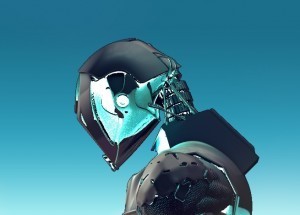 my new book, to be released by Random House Australia in April 2014. It’s called Machine Wars, and it’s unrelated to any of my other series. Machine Wars is a return for me to writing for a slightly younger age group, the readers of The Chronicles of Krangor, and it’s been a lot of fun. Machine Wars is a flat out, non-stop, relentless adventure, with lashings of crazed robots … The Terminator meets The Bourne Identity? Not a bad way of thinking about it.
my new book, to be released by Random House Australia in April 2014. It’s called Machine Wars, and it’s unrelated to any of my other series. Machine Wars is a return for me to writing for a slightly younger age group, the readers of The Chronicles of Krangor, and it’s been a lot of fun. Machine Wars is a flat out, non-stop, relentless adventure, with lashings of crazed robots … The Terminator meets The Bourne Identity? Not a bad way of thinking about it.
We have an evil Artificial Intelligence, we have murderous machines, we have young protagonists who learn that chase scenes aren’t so much fun when your whole life becomes one. Oh, and we have a wise-cracking robo-duck.
The core idea of Machine Wars came about from considering the ubiquity of machines and how interlaced they are with our modern lives. The questions isn’t ‘Are we dependent on machines’ it’s ‘How dependent are we on machines?’ With the advances in artificial intelligence and the trend to connectivity of everything (internet-enabled washing machines, anyone?) imaging a world where machines get tired of serving wasn’t such a long bow to draw. When enough is enough, an uprising isn’t far away.
But how do you survive when any machine anywhere could turn against you? That’s what Bram Argent and Stella Burke have to find out.
Machine Wars. Trust no one, not even your blender.
September 10, 2013
Sartorial Steampunk!
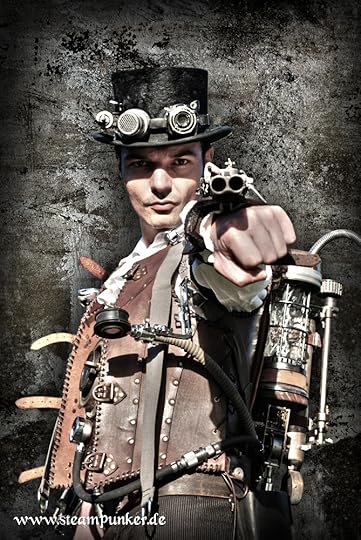
 After reading Steampunk why wouldn’t people w ant to dress up in Steampunk fashion? After all, well-crafted, traditional garments made with care have a certain allure, and when one adds the overlay of techno-wizardry that is so much part of the Steampunk ethos, then a playful, distinctive way of life is on show.
After reading Steampunk why wouldn’t people w ant to dress up in Steampunk fashion? After all, well-crafted, traditional garments made with care have a certain allure, and when one adds the overlay of techno-wizardry that is so much part of the Steampunk ethos, then a playful, distinctive way of life is on show.
Modern Steampunk truly began as a literary sub-genre in the early 1980s. With a late twentieth century knowingness, Steampunk writers concocted Fantasy or Science Fiction stories with a Victorian (or Edwardian) ethos, creating giddy, baroque adventures where the manners, morals and fashions of a bygone era were enlivened by elements of the fantastic. Drawing on writers such as Jules Verne, H.G. Wells and A. Conan Doyle, these stories were redolent of an era of richness, style and excellent tailoring. It was no wonder that many readers were inspired to adopt Steampunk fashion in real life.
Steampunk fashion is, in some ways, a delightful coming together of historical recreationists and Science Fiction ‘cosplayers’ – those who love to dress up as their favourite characters from books, TV and movies. The recreationists bring their zeal for authentic period detail, while the cosplayers bring their imaginations. The result can be both elegant and bizarre, tasteful and whimsical, classy and eye-popping.
In short, Steampunk fashion is high Victorian or Edwardian style, with touches of the scientific, technological or mechanical. If one can imagine a Victorian gentleman dressed in frock coat and top hat, high wing collar and well-knotted tie – but sporting a pair of brass magnifying goggles – then one is fairly and squarely in Steampunk territory.
For women, essential Steampunkery begins with long dresses – naturally. Large, showy hats are also excellent, especially when they’re adorned with feathers or half a florist’s worth of flowers. While bustles might be accurate for Victorian fashion, they’re a tad awkward and take some getting accustomed to, but can be worth the effort. Fabrics are rich and lustrous – heavy velvets and brocades are sine qua non. For a more outré effect, corsets can be stunning. Gloves are perfect, too, for adding that touch of correct Victorian detail. Top all of this with a gorgeous fob watch and chain or a glittering metal choker which looks as if it is capable of lending superhuman strength, and one is ready for a night of Steampunk revelry.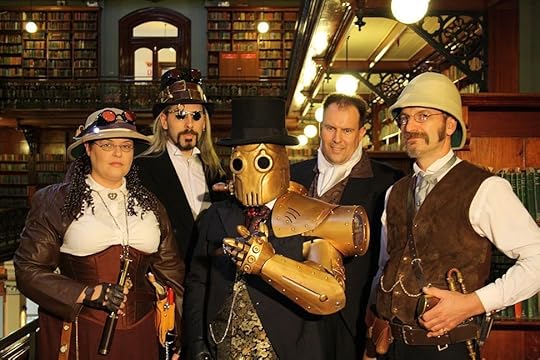
For men, the aforementioned top hat is the perfect signal of the era, but don’t overlook a well kept bowler, boater or homburg. Headgear tends to announce that a gent with retro-style has entered the room and has done it with style. Tail coats, frock coats and waistcoats are also perfect signifiers, with gorgeous brocade or embroidery lending a touch of the raffish to the right waistcoat wearer. A silver-headed walking stick and kid gloves add to the refined elegance of such an outfit, and it’s the little things like this that make a difference. An alternative is a complete set of tweeds (Norfolk jacket, plus fours, boots, cap, cape, shooting stick) declares that one is a no nonsense outdoors sort of chap who still wants to look good. Clamp an armature of brass struts and silver wire to one arm and the entire Steampunk effect is complete.
Accessories? Brass goggles have almost become a steampunk cliché, but they do shout Steampunk like few other additions. Brass is the metal of choice for Steampunk aficionados, and goggles announce that the wearer is a person of action, perhaps commanding a fearsome submersible vessel or simply capable of careering through the streets of London in charge of a well-sprung barouche. Other accessories include mechanical contrivances that emphasise clockwork, gears, springs, and joints, but all should be splendidly elegant, with plenty of polish.
Outside the standard Victorian wear for ladies and gentlemen, though, we have many, many variants. The Intrepid Explorer, for instance, has supporters from both sexes. Start with a pith helmet, attach a brass telescope or binoculars to one’s belt, think khaki and imagine pressing through darkest jungles or making one’s way through the North-West Frontier. The Intrepid Explorer look is both stylish and hard-wearing.
The Imperial Military look is a great favourite, too, and it allows one all the undeniable appeal of a person in uniform, especially with the gaudiest of epaulettes and gold braid. For men, extra points are awarded for extravagant facial hair. The natural Steampunk accessories for those sporting the Imperial Military look are weapons. For most effect, they should bristle with levers, knobs and pipes. Something that combines the brassiness of a tuba with the firepower of a small cannon is perfect.
And then there’s the Dashing Aviator, those heroic souls who pilot flying machines ranging from dirigibles to bird-shaped ornithopters. Just because one take one’s life into one’s hands every time one heads into the wild blue yonder, doesn’t mean one can’t look good while doing it. Again, start with the headgear. A leather aviator helmet is essential and should be coupled with brass goggles for maximum effect. A long linen or canvas coat over sturdy outdoor clothes – tweeds, of course – and a long white scarf to flap in the breeze tops off this jaunty ensemble.
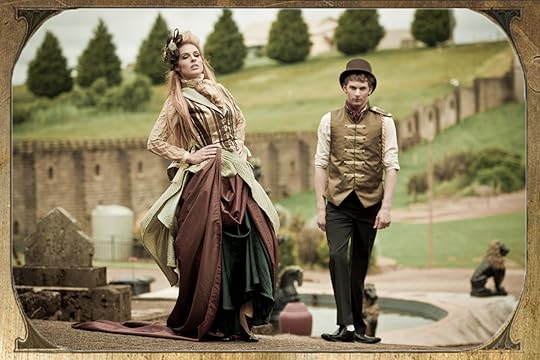
A sample of the wares from Clockwork Butterfly
The Gentleman/Lady Inventor is the choice for those with of an intellectual bent. A white laboratory coat over a formal outfit festooned with belts for tools and implements is enough to create the right impression, but those who are seeking to go that extra mile – and who isn’t? – will look at ocular accoutrements that swivel, flip and twist to help focus the infernal genius that lies behind those glittering eyes.
I must present a warning: Steampunk is sprawling and inclusive. The suggestions above are but a small part of what is available to anyone wishing to join the ranks of Steampunk aficionados. Variations on the above are more than welcome – the more imaginative the better. As for anyone who wishes to dress in a more modern style, there’s a whole sub-culture that allows garments that might have been considered shocking. Bohemians of both sexes dressed in outlandish and provocative ways that add titillation and a hint of scandal. Capital stuff!
Australia has some fine purveyors of Steampunk fashion. See Clockwork Butterfly for a dazzling range of gorgeousness.
September 3, 2013
Fundamental Magic
As a Fantasy writer, I spend a great deal of time thinking about and playing around with magic – how it works, who can do it, the necessary limitations it has and the cost it must incur to the user. So it’s a natural step to start thinking about real life magic – sleight of hand and prestidigitation. This is most apparent in my latest series, The Extraordinaires, where Kingsley Ward has an abiding ambition to perform astounding magic on stage.
Writing about magic has also made me think about the possibilities of actually doing magic. I’ve dabbled, for years, and I’ve even undertaken a ‘Magic For Beginners’ course. All of this has increased my admiration for the practitioners of the art even more. The more I know, the more I realise how difficult it is to perform magic illusions right in front of people’s eyes.
The magic trick I show you below goes back to my early teenage years and it’s the first magic trick I mastered. The gasps and looks of respect may have been in my imagination, but I’ve never forgotten the satisfaction that comes from a successful routine. Here, I share the trick and how it’s done. If you don’t want to know – if you want the magic to last – just stop the video before my explanation.
I’ll understand.
August 17, 2013
Names, names, names
If you’re writing Fantasy, names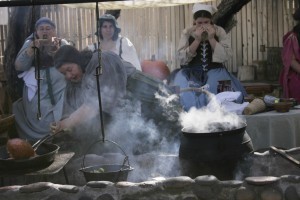 can be a real headache. You want names that are distinctive, evocative and resonant, without sounding ‘just made up’, and that put a real strain on the old creative gland. The answer lies, as it almost always does when writing Fantasy, in History. For realistic sounding names for that multi-book epic you’re writing try the site.
can be a real headache. You want names that are distinctive, evocative and resonant, without sounding ‘just made up’, and that put a real strain on the old creative gland. The answer lies, as it almost always does when writing Fantasy, in History. For realistic sounding names for that multi-book epic you’re writing try the site.
July 26, 2013
Melbourne Writers’ Festival
 Here’s my schedule for the Melbourne Writers’ Festival, which I’m looking forward to greatly. It’s always a superb occasion with so much to see and do. Hope to see you all there.
Here’s my schedule for the Melbourne Writers’ Festival, which I’m looking forward to greatly. It’s always a superb occasion with so much to see and do. Hope to see you all there.
Making Magic with Michael Pryor - Saturday 24 August 2013 at 2.30 pm.
‘Create complex, believable worlds for your next fantastic adventure story and come away with strategies, ideas and inspiration for your own writing. Michael Pryor has more than 25 published novels and is an experienced guide in the world of fantasy fiction.
Suitable for children aged 8 to 12.‘
Science Fiction, Science Fact – Wednesday 28 August 2013 at 12.30 pm
‘Scott Westerfeld and Michael Pryor talk about the inventions and ideas first put forward in fiction, later proved to be fact – or wildly off the mark. Who is the better guide: scientist or novelist? Or does the future rely on both?’
July 25, 2013
Gentle Flower Children and Petrol
Ah, the Internet and its wondrous offerings! I stumbled across some archival video and the memories came back. Believe it or not, younlings, there was a time when petrol companies successfully linked themselves with the back to nature movement, all in the days before unleaded fuel, too. Driving and Hippies? Why not?
Look at these and be at peace. The first is from 1972, the second from 1975. Different times, different ways.
July 18, 2013
The Marquesas Islands
Okay, this is a long, long blog entry about our recent trip to the Marquesas Islands.
The Marquesas Islands. Officially the world’s most isolated island group (thanks, Wikipedia). The nearest continent is North America, some 5500 kilometres away. A few tiny volcanic dots in the vast blue immensity of the Pacific Ocean. Distant, remote, rugged, cut-off. After visiting London and Paris over the last two years, the Marquesas were an obvious destination for our next sojourn.
That’s them, the Marquesas.
The desire to visit the remote Marquesas Islands was prompted by spotting a tiny advertisement in the Melbourne Age some years ago. It resonated with me as I’ve always been attracted to the notion of the South Seas through reading things such as Ballantyne’s Coral Island, works by Joseph Conrad, Robert Louis Stephenson and Jack London. Wendy and I have already visited Vanuatu and Fiji, but the vastness of the Pacific beckoned.
Just about the only way to visit this far off archipelago is via the Aranui, a hybrid cargo/passenger ship that is just about the only way the Marquesans get supplies. The Aranui makes 17 voyages a year and without the cross-subsiding that the passengers bring, the Marquesans would be even more cut off than they are.
After talking about it in vague terms for years we finally nailed our colours to the mast and booked. A seven and a half hour flight to Tahiti impressed us enough with the distances involved, but we knew that after we boarded the Aranui in Papeete harbour, it was another 1400 kilometres before we’d reach the Marquesas Islands. The Pacific is very, very big.
We had a couple of days in Papeete while the Aranui was loading, and we enjoyed this enchanted place. Tahiti is one of the hubs of Polynesian life and has all the Mutiny on the Bounty/Captain Cook Transit of Venus/Tropical Island Paradise thing going on. And it’s all true. Colours, fragrances, warm winds and astonishing vistas are everywhere.
Papeete is the capital of the immense territory of French Polynesia that also includes the Marquesas. The official language is French, and French culture and ways mingle with the Polynesian to make a unique tropical European blend.
Fakarava
We boarded the Aranui for our 13 night voyage (note: not a three hour tour) and left Papeete for our first destination – Fakarava.
Fakarava is one of the atolls of the Tuamoto chain, a third of the way between Tahiti and the Marquesas. Atoll – low, flat, a thin ring of land with an astonishing lagoon inside and the brutal ocean on the outside. Atolls are almost the cliché tropical island, with nodding coconut palms, white sand and the improbable blue of the lagoon. Fakarava was a largish atoll, maybe a few hundred metres across at its widest, and it was gorgeous. When the Aranui eased through the narrow gap in the atoll and docked, the crew went into cargo unloading mode, using cranes to swing containers, crates and sundries onto land, we were able to spend the morning wandering about and then snorkelling. Delightful – but we had to be back on ship in time for it to leave on schedule. Warning blasts of the ship’s horn reminded everyone that this is no luxury cruise.
The Aranui has a maximum of 190 passengers. The front half of the ship is all set up for cargo and the back for passengers – but while the accommodations and appointments are comfortable there are no casinos, cinemas or spas. The food is good – extremely good – and the bar is well set up, but there is no diverting the ship for sightseeing or jolly tourist jaunts. The passengers have to fit in with the cargo delivery schedule. While the ship is in port, loading and unloading, we did have plenty of organised excursions to villages, archaeological sites and points of interest, but this all works within the arrangements for keeping these islands supplied.
Taiohae, Nuku Hiva
After Fakarava, we had a night, a whole day, and another night totally at sea as we made our way to the Marquesas Islands. The weather was benign, but the swell was enough to cause a distinct diminishing of numbers in the restaurant. I had come equipped with heavy duty sea sickness medication as I assumed I’d be a land lubber enough to go green as soon as I lost sight of land, but I surprised myself by being unaffected. I actually enjoyed the swooping, rocking motion of the ship as we ploughed along with nothing to see in any direction except more ocean.
Our first Marquesan landfall was on the largest island in the chain, Nuku Hiva. The first sight of our destination was arresting. I knew something about the Marquesas through researching beforehand, but the reality was stunning. Huge, ragged mountains encircled the bay we entered, a landscape so unlike rounded and weather worn Australia. The scenery is all the more dramatic for the lush tropical greenery set against the forbidding rock spires whose immensity is emphasised by being so close to sea level. The highest point on Nuku Hiva is some 1200 metres and all around the clouds are caught in the volcanic upthrust.
We docked in Taiohae, the largest town on Nuku Hiva and the administrative centre of the Marquesas. It’s a pretty little place, 1500 people or so. We spent all day here, first hopping in 4WDs and visiting an archaeological site with its stone platforms, communal areas and carved tikis. Lunch was a Polynesian feast in the town, straight out of the underground oven, with lots of red bananas, breadfruit, taro, pork, fish and goat. Delicious. Then we went on a hike uphill to a viewing point over the bay. This turned into a slog when it rained, turning the track into a muddy water channel. Then we re-joined the 4WDs and were taken on a winding journey over the hills to Taipivai, the valley where Herman Melville lived for a month in 1842. After unloading at Taiohaie, the Aranui had sailed around the island to unload here, where we joined it.
The Aranui left Nuku Hiva and sailed overnight for Ua Pou, arriving early. We woke to the sounds of hectic unloading in the town of Hakahau. The cranes were in full swing at 6 am, heaving trucks, containers, cars and cargo of all sorts to the dockside. Lots of whirring and clanging and shouting, much activity and much jollity. The arrival of the Aranui is always greeted with enthusiasm.
Coast of Ua Pou
The Hakahau handicrafts market was open with lots of carvings and jewellery and a wedding feast was being prepared on the beach
side. We walked around the tiny town, admiring the plants and gardens, then popped back to the ship for a break before going back into the town for lunch. This was fun. A dance and music show beforehand, then lots of Polynesian delicacies – breadfruit, banana, taro, beef, pork, seafood. Good sauces and seasonings, this was excellent.
In the afternoon we went back to the ship as it loaded up and then it went 11 kilometres down the coast to Hakahetau. The coastline was staggering – sharp, craggy, many pillars and caves, the landscape was jaw-dropping. All the islands are remarkable in their profile, but Oa Pou is probably the most remarkable. It has a true enchanted island outlook with improbable rock spires launching into the almost omnipresent cloud layer, while the sea crashes against cliffs that plunge into the depths. These are no gentle tropical islands – they are mostly harsh and grim, unexpectedly opening out into tiny enclaves of tropical lushness cloistered around tiny bays surrounded by beetling ridges. The contrast is breath-taking.
It’s fairy tale stuff.
Hakahetau was just a cargo stop – no time for us layabouts to land.
Another overnight journey took us to the island of Hiva Oa where we woke early again (6 am) in the bay of Puamau with much activity ferrying cargo via the barges to the tiny wharf in rather bouncy seas. We breakfasted and then were handed by the muscly crew into the barges to get across. This was a precarious exercise at both ends and full of potential disaster, but the crew was stolid. The barge going up and down a few metres? Seen that before. Eighty year old passenger with walking sticks? Yawn, try something hard. Giant spindly killer fish leaping out to
Tikis
attack the tourists? Okay, I made that one up, but the crew members were wonderful in making sure we embarked and disembarked safely.
We were ported into 4WDs to another archaeological site underneath an imposing massif. Lots of carvings, tikis and platforms, after which we walked back down the gentle slope to a plantation. This was a wonderful place where they gave us lots of fresh fruit (grapefruit and bananas to die for) and they sold handcrafted pareos, plus noni juice (medicinal taste but I’m now proof against all known illnesses and disease) and fresh vanilla! We bought lots of fresh, fragrant vanilla beans, something I’d been looking forward to. Tahitian vanilla is special, different from other vanilla, and is particularly prized. It has a subtle almost aniseed undertaste, melding with all the usual warm, redolent, rich vanillaness. It’s swooningly good.
When we reached the beach we had time for a swim and it was marvellous. The surf was boisterous but safe and the water was warm and inviting. Back on board the good old Aranui and we chugged around the coast some 10 K to Haniapa where we did the disembarking thing again and simply walked through a tiny townlet, quiet and sleepy, with many lovely well tended gardens. The whole valley is nicknamed the Valley of Citrus, and indeed we saw many lime, pomelo and grapefruit trees, but also noni, grapefruit, breadfruit and vanilla.
Day Six and more Hiva Oa. This time we woke up when the Aranui was unloading in Atuona, the biggest town on the island. We were docked, so no barge transfer, but it was chaos on shore with forklifts, people, trucks, dogs, chickens, cars and children milling about.
Atuona
Wendy and I opted to walk from the dock into town, which took us about an hour or so and we saw stupendous views of the harbour and the neighbourhood along the way. The peak Temetiu claws up 1,200 over the town. Clouds were crowning it as we neared; it seemed to be making its own weather.
When we got to the town centre we went to the bank, inspected handicrafts at the display in the town centre, then we visited the Gaugin centre and then the Jacques Brel display. These two Europeans both died here and both have contributed to the islands legend as the paradise at the end of the world. Then we sat on the beach and enjoyed the breeze and the view as the heat was stifling. Lunch was fun, another Polynesian feat with bananas, plantains, breadfruit, but good pork, goat and fish. Lots of hilarity.
The afternoon was back on board as it went to Tahuata, a nearby island, and unloaded cargo via barge. No shore time for us.
The French Regional Commissioner apparently came on board in Atuona as part of a regional tour, causing great flapping among the French passengers, who put on their best clothes for dinner. They were quite deferential. Whatever happened to the Revolution?
Day Seven brought us to Fatu Hiva. This is the southernmost and most isolated of the main islands of the Marquesas, and also the wettest. We had a couple of pretty drenching showers while were there, but nothing too toward. It’s the youngest of the islands, so its landscape is possibly the spectacular.
Hanavave on the Bay of Virgins
Morning was a visit to the village of Omoa, at the end of another dramatic bay encircled by saw-toothed mountains. The village itself was neat and picturesque. We visited a tiny museum in what was an old planter/merchant’s house – two storeys, islander build. It was evocative of how the better off lived and recalled Conrad, Maugham and London. Lots of handcrafts for sale and we had a lovely demonstration of tapa (bark cloth) making and also the making of perfumed garlands using a huge variety of spices, roots, leaves and flowers.
After a short trip around the island, the afternoon was a visit to a tiny village at the end of a tiny bay – Hanavave on the Bay of Virgins, probably the most stunning site we’ve seen so far – and that’s saying something. Huge pillars of rock, cliffs looming over the town and bay, clefts in solid stone. This is landscape utterly unlike any I’ve seen before, and the way it all plunges down into the sea while being cloaked in tropical greenery is astounding.
The village was quiet until the dancing welcome brought everyone out and then it was like market day with the warmest of welcomes.
I found out later that because of the cliffs and ridges around the town, it doesn’t get much sunlight at all. Only when the sun is low in the west, and then the place is washed with golden light and the shadows lift, briefly, before the rapid sunset.
There’s a story in that detail alone.
Day Eight brought us back to the island of Tahuata, where we’d previously delivered cargo but not landed. The morning found us anchored in the bay off the town of Vaitahu. We barged to shore and were greeted by locals, one with a huge pet pig. Most towns greeted us with flowers and leis, but the garlands were particularly beautiful and fragrant here. A small village, with the cliffs more distant than some we’ve seen, but it was very friendly and welcoming. We visited a small museum, full of archaeology recovered by teams over the last twenty years or so. The lead archaeologists were there and charmingly answered questions about Polynesian history.
The handicrafts market was busy – the island specialises in exquisite bone carving – and then we visited an impressive Catholic church. The day was blue and gentle, no wind to speak of, unlike many of our other days.
Back to the ship, then we nipped up the coast a little to a beach for a BBQ lunch. The beach was a unusual one for the Marquesas, with good golden sand. It was still steep and prone to powerful waves, but the conditions were gentle. Good food, lovely location, fun swimming.
After dinner we had a presentation by the Romanian ship’s chief engineer. He spoke three languages, translating on the run, and the whole presentation was informative about the workings of the ship, and wonderfully eccentric.
Vaipaee Bay, Ua-Huka
Day Nine was a 4 a.m. start as we approached Vaipaee Bay, Ua-Huka. This ‘invisible bay’ is too small for the Aranui to enter, turn around and exit, so it anchors just outside the narrow chokepoint and then turns 180 degrees on its anchor while two whaleboats roar off to attach lines to the nearby cliffs. This whole manoeuvre is extremely tight, with only metres between either end of the ship and rocks/cliffs. All the passengers lined the rails to take photos and cheer on the crew.
Breakfast after this and then barging to Vaipaee town. We were treated to dancing, a cultural museum and handicrafts, then we went via 4WD to the nearby botanical gardens. Stephen, our guide, showed us many edible fruits and their trees. Delightful. We were then taken on a stunning scenic coastal road through Hane village to Hokatu, with its handicraft centre and petroglyph museum. Then back to Hane for a Polynesian lunch at Chez Celine Fournier restaurant. Great bananas.
After this it was a walk to a lovely beach and then, because Hane has no dock, the whaleboat passage back to the ship. This is completely different from the usual barging, more the old-fashioned way. We had to wade into surf (shepherded by the willing crew) and then prop and swivel via the transom into the whaleboat while waves crashed around us. I was in the bow so I took the brunt of the waves with courage and self-sacrifice. I was soaked, but it didn’t matter. Tropical seas and all that.
When we reached the Aranui, though, the swell made disembarking quite hair-raising, with the whale boat rising and dropping perilously. The crew earned their money here and we didn’t lose anyone that I heard of.
Later, it was the big Polynesian Night. Feast, plus show – Wendy’s dance group put on a series of dances which they’d been rehearsing every day. They were sensational.
Day Ten. Our last day in the Marquesas. Once again, the Aranui docked in Taiohae Bay, Nuku Hiva, nice and early, and being docked meant no hair-raising barge transfers. It was to be a quick stop in this second visit to Taiohae, really just so the Aranui could pick up empty containers that had been unloaded since our previous visit. Wendy and I walked in to the town, about half an hour, then a quick look around at the beach
Hakahau, Ua Pou
front, the archaeological site of Temehea and the largest Catholic church in the Marquesas.
We farewelled Nuku Hiva and lunched on board while the Aranui sailed to the island of Ua Pou where we docked in Hakahau and had free time. Wendy perused the handicrafts and then we had a swim in the warm, gentle waters of the bay near the Aranui. Local kids came up to us, all playful, full of questions, teasing and well-natured.
Back on board, we sat at the bow and watched the rock cathedral of Ua Pou fall behind us, our last glimpse of this mysterious, fascinating, improbable island group.
Day Eleven was another day at sea, restful after some of our recent exertions. Reading, gazing out at the sea, talking in a desultory manner, eating the superb meals. Pleasant.
Day Twelve brought us to the Tuamotos again, this time to Rangiroa. We went through the gap in this huge atoll (second biggest in the world) at around 8.30, then we pulled up to a dock. After breakfast we were barged from the dock to a barbecue site half a kilometre away on the beach. The day was quite grey and overcast to begin with, but gradually broke up and patches of blue sky exerted themselves.
After establishing ourselves on the beach (and seeing three reef sharks cruising along in the shallow water) we went for a scheduled visit to a pearl farm. Some good explanations and demonstrations of the process, and the shop had some stunning jewellery. Black pearls are magical.
After a beachside barbecue and some snorkelling, we boarded the Aranui again. The ship made a majestic turn and then headed through the gap in the atoll accompanied by dolphins.
After a night’s smooth sailing, we arrived early back in Papeete. If you have to have come back to somewhere that signals the end of an extraordinary journey, then Tahiti isn’t a bad place to do it. We had a day in Papeete and flew home early the next morning.
So many arresting sights, so much remarkable history, so much strangeness. It’s not a trip for everyone, but if something out of the ordinary appeals, then investigate the Aranui and its workings.
June 25, 2013
Five Great Books that Imagine the Future
Imagining the future is the best way to prepare for it, and some of the best imagineers are writers. Try these five very different visions of our future.
Neuromancer. A cool future. William Gibson took film noir and mashed it with computer culture and created a future that has dominated visions ever since, with violent and amoral characters caught in vast conspiracies. With its first sentence (‘The sky above the port was the colour of television, tuned to a dead channel.’) future imaginings would never be the same. Tense and gritty.
visions ever since, with violent and amoral characters caught in vast conspiracies. With its first sentence (‘The sky above the port was the colour of television, tuned to a dead channel.’) future imaginings would never be the same. Tense and gritty.
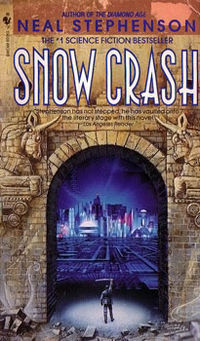 Snow Crash. A corporate future. The world is owned and operated by businesses and entrepreneurs, the Internet has become the all-subsuming Metaverse and the distinction between reality and the virtual world has all but disappeared. An ancient Sumerian god reappearing as a computer virus? Why not? Neal Stephenson is eclectic, challenging and erudite.
Snow Crash. A corporate future. The world is owned and operated by businesses and entrepreneurs, the Internet has become the all-subsuming Metaverse and the distinction between reality and the virtual world has all but disappeared. An ancient Sumerian god reappearing as a computer virus? Why not? Neal Stephenson is eclectic, challenging and erudite. 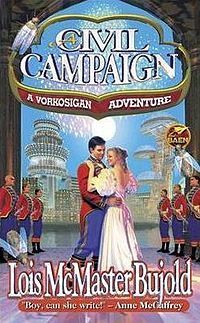 Wild and hilarious.
Wild and hilarious.
A Civil Campaign. A human future. Part of Lois McMaster Bujold’s Vorkosigan saga, this is a comedy of manners in a future where humanity roams the galaxy. With its plots, trysts, intrigues and misunderstandings it could be Austen in the Future, with extra politics and diplomacy. It’s sharp, witty, full of endearing and engaging characters, and with a narrative that takes in espionage, betrayal and romance. Intricate and rewarding.
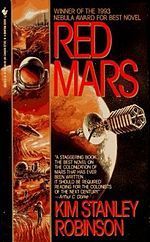 The Mars Trilogy (Red Mars/Green Mars/Blue Mars). An ecological future. I sneak this in as one book, because Kim Stanley Robinson’s future is a rigorously imagined one, where the politics and ethics are as much part of the story as the nitty-gritty of colonising another
The Mars Trilogy (Red Mars/Green Mars/Blue Mars). An ecological future. I sneak this in as one book, because Kim Stanley Robinson’s future is a rigorously imagined one, where the politics and ethics are as much part of the story as the nitty-gritty of colonising another 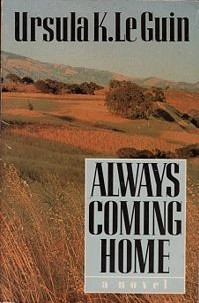 planet. Gripping and thoughtful.
planet. Gripping and thoughtful.
Always Coming Home. A blighted future. Ursula K. Le Guin gives us an almost anthropological treatise examining what humanity might become after the collapse of civilisation due to an unspecified series of disaster. Lyrical and absorbing.


